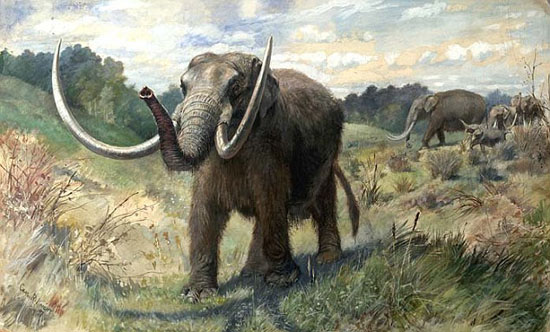(单词翻译:单击)
In their keenness to demonstrate the incognitum's bulk and ferocity, the American naturalists appear to have become slightly carried away. They overestimated its size by a factor of six and gave it frightening claws, which in fact came from a Megalonyx, or giant ground sloth, found nearby. Rather remarkably, they persuaded themselves that the animal had enjoyed "the agility and ferocity of the tiger," and portrayed it in illustrations as pouncing with feline grace onto prey from boulders.
在热心展示那头不知名动物如何庞大和如何凶猛的过程中,博物学家们似乎有点儿得意忘形。他们把它的个儿拔高了6倍,还给它加上了可怕的爪子。实际上,那不过是在附近发现的一只大树懒的爪子。很有意思的是,他们认为那种动物“灵活和凶猛得像老虎”,在插图里把它描绘成躲在巨砾后面,以猫科动物的优美姿态准备扑向猎物。

When tusks were discovered, they were forced into the animal's head in any number of inventive ways. One restorer screwed the tusks in upside down, like the fangs of a saber-toothed cat, which gave it a satisfyingly aggressive aspect. Another arranged the tusks so that they curved backwards on the engaging theory that the creature had been aquatic and had used them to anchor itself to trees while dozing. The most pertinent consideration about the incognitum, however, was that it appeared to be extinct—a fact that Buffon cheerfully seized upon as proof of its incontestably degenerate nature.
长牙发现以后,他们又挖空心思地以各种方式把它们安在它的头上。有一位用螺丝把长牙倒着拧在上面,就像剑齿虎的犬牙那样,使其看上去特别气势逼人。另一位把长牙向后弯曲,其动听的道理是,那个家伙原本是水生动物,打盹时用牙齿将自己泊在树上。然而,最贴近事实的看法是,这种不知名的动物已经灭绝——布丰连忙抓住了这一点,把它作为那种动物已经无可争议地退化的证据。
Buffon died in 1788, but the controversy rolled on. In 1795 a selection of bones made their way to Paris, where they were examined by the rising star of paleontology, the youthful and aristocratic Georges Cuvier. Cuvier was already dazzling people with his genius for taking heaps of disarticulated bones and whipping them into shapely forms. It was said that he could describe the look and nature of an animal from a single tooth or scrap of jaw, and often name the species and genus into the bargain. Realizing that no one in America had thought to write a formal description of the lumbering beast, Cuvier did so, and thus became its official discoverer. He called it a mastodon (which means, a touch unexpectedly, "nipple-teeth").
布丰死于1788年,但争论没有停止。1795年,一批精心挑选的骨头运到了巴黎,接受古生物学界的新秀、年少气盛的贵族乔治·居维叶的审查。居维叶不费多少工夫就能把一堆堆支离破碎的骨头安放成形,人们已经对他的才华赞叹不已。据说,只要看一颗牙齿或一块下巴骨,他就可以描述出那个动物的样子和性情,而且往往还说得出它是哪个种,哪个属。居维叶发现美国还没有人想到要写一本正式描述那类大动物的书,便自己动手写了,于是成了发现那种动物的第一人。他把它叫做“乳齿象”(意思是“长有乳头般隆起的牙齿的象”。出人意料的是,这还真有点儿像)。


